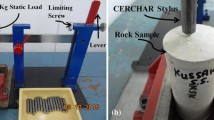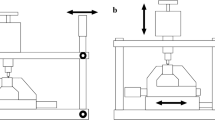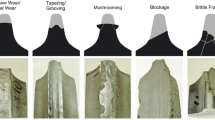Abstract
The Cerchar abrasion index is commonly used to represent rock abrasion for estimation of bit life and wear in various mining and tunneling applications. Although the test is simple and fast, there are some discrepancies in the test results related to the equipment used, condition of the rock surface, operator skills, and procedures used in conducting and measuring the wear surface. This paper focuses on the background of the test and examines the influence of various parameters on Cerchar testing including pin hardness, surface condition of specimens, petrographical and geomechanical properties, test speed, applied load, and method of measuring wear surface. Results of Cerchar tests on a set of rock specimens performed at different laboratories are presented to examine repeatability of the tests. In addition, the preliminary results of testing with a new device as a potential alternative testing system for rock abrasivity measurement are discussed.



















Similar content being viewed by others
References
AFNOR (2000) Roches De′termination du pouvoir abrasive d’uneroche Partie 1: Essai de rayure avec une pointe. NF P 94-430-1, Paris
Al-Ameen S, Waller M (1994) The influence of rock strength and abrasive mineral content on the Cerchar abrasive index. Eng Geol 36:293–301
Alber M (2008) Stress dependency of the Cerchar abrasivity index (CAI) and its effects on wear of selected rock cutting tools. Tunn Undergr Space Technol 23:351–359
Cerchar (1986) Centre d’Etudes et Recherches de Charbonnages de France. The CERCHAR abrasiveness index, Verneuil 12S
Dahl F, Bruland A, Jakobsen PD, Nilsen B, Grøv E (2012) Classifications of properties influencing the drillability of rocks, based on the NTNU/SINTEF test method. Tunn Undergr Space Technol 28:150–158
Hamzaban MT, Memariana H, Rostami J (2013) Continuous monitoring of pin tip wear and penetration into rock surface using a new Cerchar abrasivity testing device. Rock Mech Rock Eng, Available online in March
Käsling H, Thuro K (2010) Determining abrasivity of rock and soil in the laboratory. In: 11th IAEG Congress, Auckland, New Zealand, p 235 1973–1980
Lee S, Jeong HY, Jeon S (2013) Assessment of TBM cutter wear using Cerchar abrasiveness test. In: Proceedings of world tunneling conference (WTC), Geneva, Switzerland, Paper #13–177
Michalakopoulos T, Anagnostou V, Bassanou M, Panagiotou G (2006) The influence of steel styli hardness on the Cerchatr abrasiveness index value. Int J Rock Mech Min Sci 43:321–327
Natsis A, Petropoulos G, Pandazaras C (2008) Influence of local soil conditions on mouldboard ploughshare abrasive wear. Tribol Int 41(3):151–157
Plinninger R, Kasling H, Thuro K, Spaun G (2003) Testing conditions and geomechanical properties influencing the Cerchar abrasiveness index (CAI) value. Int J Rock Mech Min Sci 40:259–263
Plinninger R, Kasling H, Thuro K (2004) Wear prediction in hardrock excavation using the CERCHAR Abrasiveness Index (CAI). In: Proceedings of the Eurock 2004 and 53rd Geomechanics Colloquium, p 599–604
Rostami J, Ozdemir L, Bruland A, Dahl F (2005) Review of issues related to Cerchar abrasivity testing and their implications on geotechnical investigations and cutter cost estimates. In: Proceedings of the RETC, p 738–751
Schimazek J, Knatz H (1970) Der einfluss des gesteinsaufbaus auf die schnittgeschwindigkeit und den meisselverschlers von stricken vortriebs maschinen. Glückauf 106:274–278
Stanford J, Hagan P (2009) An assessment of the impact of stylus metallurgy on Cerchar abrasiveness index. In: Proceedings of the Coal Operators’ Conference, p 348–355
Suana M, Peters T (1982) The Cerchar abrasivity index and its relation to rock mineralogy and petrography. Rock Mech 15:1–7
Tamrock (1999) In: Heiniö M (ed) Rock excavation handbook. Sandvik tamrock Corp, p 305
Thuro K (1997) Drillability prediction: geological influences in hard rock drill and blast tunnelling. Int J Earth Sci 86:426–438
Thuro K, Singer J, Käsling H, Bauer M (2007) Determining abrasivity with the LCPC test. In: Eberhardt E, Stead D, Morrison T (eds) Proceedings of the 1st Canada–U.S. rock mechanics symposium, 27-31.05.2007. Taylor & Francis, Vancouver B.C, London
West G (1986) An observation on Mohs’ scale of hardness. Q J Eng Geol Hydrogeol 19:203–205
West G (1989) Rock abrasiveness testing for tunnelling. Int J Rock Mech Min Sci Geomech Abstr 2:151–160
Yarali O, Yasar E, Bacak G, Ranjith P (2008) A study of rock abrasivity and tool wear in coal measures rocks. Int J of Coal Geol 74:53–66
Acknowledgments
Several individuals and organizations have collaborated with the authors on this project and their input and participation is appreciated. This includes Advanced Terra Testing, Inc. and Dr. Hamid Nazeri, Mr. Brian Asbury of Colorado School of Mines, Dr. Chris D. Breeds of SubTerra, Inc., Mr. Gregory Thomas of TerraSense, LLC., Dr. Fulvio Tonon of Tonon Engineering Services in Austin Texas, Prof. Jeon of Seoul National University in Korea, and researchers in NTNU, Trondheim Norway.
Author information
Authors and Affiliations
Corresponding author
Rights and permissions
About this article
Cite this article
Rostami, J., Ghasemi, A., Alavi Gharahbagh, E. et al. Study of Dominant Factors Affecting Cerchar Abrasivity Index. Rock Mech Rock Eng 47, 1905–1919 (2014). https://doi.org/10.1007/s00603-013-0487-3
Received:
Accepted:
Published:
Issue Date:
DOI: https://doi.org/10.1007/s00603-013-0487-3




